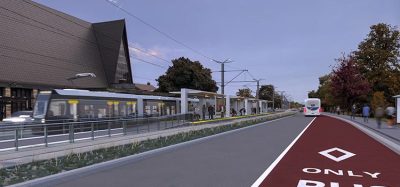Twin steel bands for the Ordsall Chord are lifted into place
Posted: 14 August 2017 | Global Railway Review | No comments yet
The final eye-catching piece of the Ordsall Chord, which will improve connectivity across the north of England, has been lifted into position by Network Rail. See here for video…
The design vision of BDP’s Transport Architect Director, Peter Jenkins, the twin steel cascades complete the final part of the first network arch bridge in the UK.
“The overall concept for the bridges is that of a continual, flowing ribbon which incorporates individual structures into a single over-arching identity,” said Peter Jenkins who is new Head of Transport for the BDP worldwide. “This latest piece of steelwork connects the River Irwell and Trinity Way bridges with a twisting, sinuous form which smoothly brings the concept of the structure to fruition. The development has been a true team effort from the original sketch through to construction, integrating different people and different tools to achieve the vision.”
The bridge is the centrepiece of the Ordsall Chord and the Manchester studio of BDP (an international interdisciplinary practice of architects, designers, engineers and urbanists) has played a key part in the mammoth civil engineering rail project. The line will link Manchester’s Piccadilly and Victoria rail stations for the first time and unlock new routes and improve connections and journey-times across the north of England.
The Ordsall Chord line consists of 300m of track and a series of new bridges and viaducts designed by BDP in conjunction with engineers from Parsons Brinkerhoff, Aecom and Mott MacDonald.
When the entire project is finished by December 2017, it will provide new and direct links from the north to Manchester Airport, and help support Network Rail’s Great North Rail Project, part of the wider Railway Upgrade Plan.
“The installation of the cascades completes the final and unique steel ribbon-effect which runs along the outside of the network arch bridge,” said Allan Parker, programme manager for Network Rail. “We’ve reached yet another major milestone in the project and I would like to thank all the teams who have played an integral role in making this happen.”
Work will now continue on the remainder of the project. This will involve laying ballast and track on the 1600 tonne bridge as well as further track work, signal work and installing overhead line equipment to allow electric trains to run.








